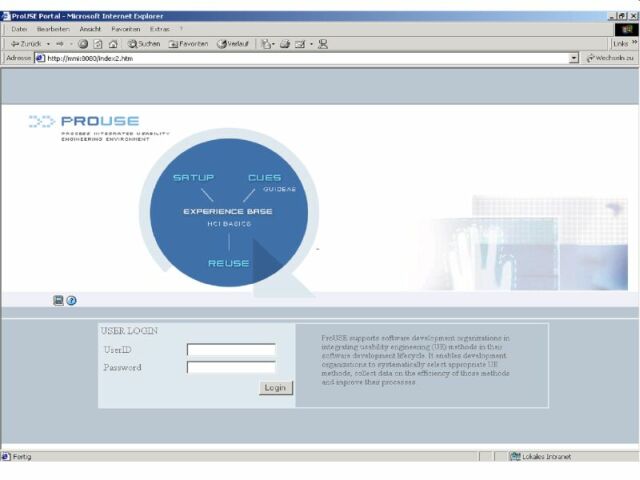ProUSE
Process Centered Usability Engineering Environment

Members
Reiterer, Müller, Klein, Limbach
Description
Since 2000 the working group information systems has been developing a usability engineering environment that serves as an overall support of all phases constituting an exemplary process of usability engineering. The generation of ProUSE is part of a project developed in cooperation with DaimlerChrysler in Ulm (research department for software technologies). This environment is meant to guarantee availability of a tool based usability engineering environment for everybody partaking in a software project (e.g. designer, developer, usability engineer).

This computer tool is going to be an intranet based software that allows everybody involved in a software project to access the necessary information about usability engineering.
Besides imparting specific information, their respective application has to be supported, as well. The essential fields of knowledge are the following:
- model process of usability engineering (based on ISO 13407), including the definition of roles and tasks of the people involved.
- principles of design and basics of both HCI and Usability Engineering
- methods of Usability Engineering (e.g. methods used for realizing task analysis, user profiling, development of style guides)
- tools of Usability Engineering (e.g. what kind of tool support exists, when to employ which)
- experiences from previous projects (e.g. design decisions, prototypes)

The accessibility of the five mentioned fields of knowledge serves to support the following tasks:
- project management: the manager of a software project is able to define the roles of those who take part in the development process by means of a given model process. The tool allows for adapting the given model to the concrete situation of the respective project. Besides, the project manager gets an overview of the methods and tools necessary for the realization of the model.
- quality management: The precise guideline of procedure, methods, tools, roles etc. makes sure that the preliminary quality standards are met as early as during development. As a consequence the end products fulfill the conditions of quality assurance. This complies with the latest ideas of software quality assurance according to CMM (ISO/IEC TR 15504) and SPICE.
- information management: Providing know-how gained during previous development projects permits a general information exchange. Eventually, the externalization of information might even help to make project issues less dependent on individuals.
